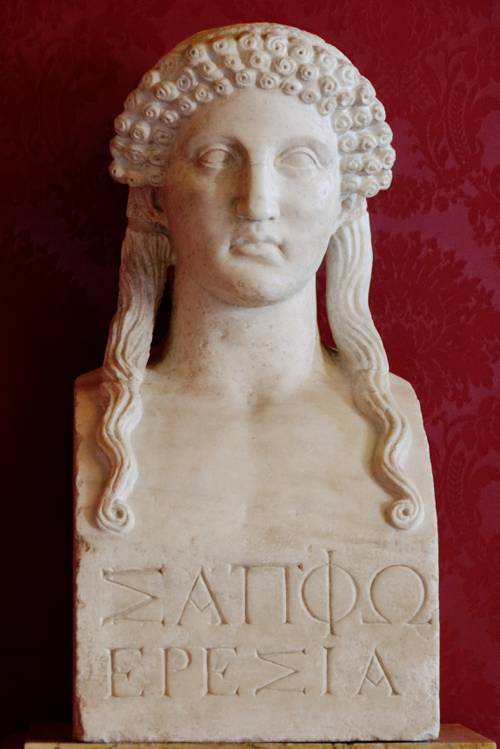
FAQ About Sappho of Lesbos

Who was Sappho of Lesbos?
Sappho of Lesbos was an ancient Greek poetess born around 630/612 BCE on the island of Lesbos. She is renowned for her lyric poetry, which often explores themes of love and passion. Her work was highly admired in antiquity, and she was sometimes referred to as the 'Tenth Muse.' Much of her poetry has been lost, but the surviving fragments continue to be studied and celebrated for their emotional depth and personal insight.

Why is Sappho considered important in classical literature?
Sappho is considered a crucial figure in classical literature due to her significant contribution to the genre of lyric poetry. Her work's emotional intensity, personal expression, and innovative use of meters set a new standard for poetry in the Greek world. Her exploration of personal emotions and relationships was pioneering, influencing countless poets and writers who came after her.

What are the themes commonly found in Sappho's poetry?
Sappho's poetry is renowned for themes of love, passion, and the complexities of personal relationships. Her work often explores the nuances of romantic affection, longing, and the joy and pain associated with love and desire. Some of her poems also touch on themes of friendship, the beauty of nature, and the celebration of female experience.

What is known about Sappho's life?
Details about Sappho's life are sparse and often derived from historical speculation and ancient sources. She was born on the island of Lesbos, and her family was likely aristocratic. There are claims that she had a daughter named Cleis. Sappho lived during a time of social and political upheaval, and she may have spent time in exile in Sicily. Much of her life remains a mystery, contributing to the mythic status she holds in literature.

What do we know about the societal role of women like Sappho in ancient Greece?
In ancient Greece, women's roles varied greatly depending on their locality and social status. On the island of Lesbos, where Sappho lived, women may have had more autonomy and influence, particularly in artistic and religious circles. Sappho's poetry suggests she was part of a circle of women involved in artistic and literary activities, possibly related to religious rites or social gatherings where poetry was shared. Her work indicates a community where close female relationships and artistic expression were valued.

How much of Sappho's poetry survives today?
Only a small portion of Sappho's poetry survives today. While she was reportedly very prolific, composing over nine volumes of poetry, nearly all has been lost to history. Currently, scholars have access to only a handful of complete poems and various fragments, which have mostly been preserved on papyri and pottery shards. These remnants continue to be highly regarded for their literary quality and emotional resonance.

What is the significance of the term 'Lesbian' in relation to Sappho?
The term 'Lesbian' is derived from the island of Lesbos, where Sappho lived. Sappho became famously associated with expressions of love and affection towards women, giving rise to the modern term 'Lesbian' referring to female homosexuality. However, interpretations of her sexual orientation and the role in her poetry range widely. The connection underscores her impact on literary history and vocabulary.

What is the most famous work attributed to Sappho?
Perhaps the most famous work attributed to Sappho is the 'Ode to Aphrodite,' the only complete poem of hers that has survived intact. In this poem, Sappho calls upon the goddess of love, Aphrodite, to aid her in matters of the heart. This work is celebrated for its rich language, beautiful imagery, and insight into both divine and human love.

What are some misconceptions about Sappho?
One of the most common misconceptions about Sappho is that all her poetry was exclusively about love between women. While many of her poems do explore female relationships, they also encompass a broader range of themes like love in general, personal reflection, and public events. Another misconception is that Sappho's sexuality is clearly defined; in reality, her work encompasses a complex and nuanced view of love and relationships that is open to interpretation.

Was Sappho known to have any notable contemporaries?
During Sappho's time, a number of lyric poets and artists were part of the Greek cultural scene. One notable contemporary was Alcaeus, a fellow poet from Lesbos, who is sometimes thought to have interacted with Sappho. Their relationship, whether personal or purely literary, remains a topic of fascination and speculation, often reflected in surviving literary fragments and anecdotes from ancient commentators.

Why was Sappho referred to as the 'Tenth Muse'?
Sappho was referred to as the 'Tenth Muse' by admirers who considered her work to be of divine inspiration, alongside the nine muses of Greek mythology who were considered to be the personifications of knowledge and the arts. This accolade reflects the high regard in which her poetry was held in antiquity, often praising her ability to evoke deep emotion and insight through her verse.

How did Sappho's work influence later generations?
Sappho's influence on later generations is profound, having inspired poets and writers throughout history. Her innovative use of lyric meter and expression of personal emotion pioneered a new poetic style that was emulated by many, including Roman poets like Catullus and Ovid. Her focus on individual experience and introspection laid the groundwork for later developments in the genre of lyric poetry.

What does the term 'Sapphic meter' mean?
'Sapphic meter' refers to a specific poetic meter named after Sappho, who frequently used it in her poetry. It consists of four lines, the first three being eleven syllables each with a pattern of stresses, and the fourth line having five syllables. This metrical form was used by Sappho to convey the lyrical and musical qualities of her poetry, and it has been adopted by various poets over subsequent centuries.

Are there any artifacts or ancient sources that mention Sappho?
Several ancient sources mention Sappho, including poets and scholars from antiquity such as Horace, Plato, and later writers like Ovid. Her work is occasionally cited in the writings of historians like Herodotus. In addition to literary mentions, some physical artifacts like ancient pottery and papyri fragments preserve snippets of her work, further demonstrating her impact across various historical records.

How did scholars reconstruct Sappho's poems?
Scholars have reconstructed Sappho's poems from fragmented papyri, citations in ancient anthologies, and quotes by later authors. Many fragments are derived from Oxyrhynchus papyri, a significant collection of ancient manuscripts discovered in Egypt. These remnants are pieced together with references found in ancient Greek literary critiques and commentaries to better understand her oeuvre.

What role did Sappho play in the cultural context of Lesbos?
In the cultural context of Lesbos, Sappho is thought to have played an important role as a poet and a leader of a circle of young women engaged in the arts. This group might have been part of a thiasos, a literary and religious gathering centered around rituals of worship to deities like Aphrodite, where poetry was an integral component. Sappho's leadership and literary production contributed to the cultural and artistic life on the island.

How did Sappho's reputation change over time?
Sappho's reputation has evolved dramatically over time. In antiquity, she was celebrated for her artistic skill and emotional depth. During the early Christian period, her works faced censorship due to their themes of love and sexuality. In modern times, however, she has been reclaimed as an icon of female artistry and expression, revered for her bold voice and significant impact on literature.

Are there any modern interpretations of Sappho's work?
Yes, Sappho's work continues to inspire modern interpretations in literature, art, music, and dance. Her themes of love and passion have proved timeless, with many artists and writers drawing inspiration from her exploration of these emotions. Contemporary poets have translated her work and experimented with Sapphic meter, while others have created new works that dialogue with her legendary themes and style.

How is Sappho represented in popular culture today?
In popular culture today, Sappho is often represented as a symbol of female empowerment and LGBTQ+ history. Her life and poetry have inspired countless artistic works, including novels, plays, films, and visual art. Her persona and poetry continue to capture the imagination, serving as both a muse and a subject of reinterpretation by modern artists and writers seeking to evoke and explore themes of love and identity.

What makes Sappho's poetry unique compared to other ancient poets?
Sappho's poetry is unique compared to other ancient poets due to its deeply personal and emotional content. While other poets often focused on epic narratives or public themes, Sappho's work is intimate and subjective, offering insights into individual emotions and relationships. Her innovative use of vernacular language and personal voice distinguishes her work, creating a lasting legacy in the tradition of lyric poetry.
